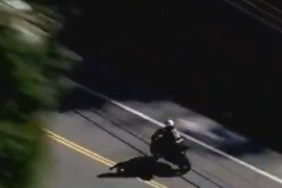In 1853, just three years after it was incorporated, Los Angeles found itself at a crossroads. The city was reputed to have the highest murder rate nationwide, as the California Gold Rush brought cutthroats to town. Desperate to turn the tide, the first specific Los Angeles police force was founded and staffed with volunteers, who in turn earned a reputation for indulging in violence, gambling, and vice. A century later, the LAPD had become notorious for widespread corruption, racism, and brutality. This is where our story begins.
Also: Curator Pete Brook Looks at the Prison Industrial Complex From the Inside Out
James Ellroy, the undisputed master of modern crime noir, has joined forces with and Glynn Martin, executive director for Los Angles Police Museum to create LAPD ’53 (Abrams) a devastating portrait of the era through. The book features 80 duotone photographs, sprinkled throughout the book, showing the particulars of the grim and ghastly tales Ellroy narrates. Imagine the underbelly of Hollywood Babylon, if it were illustrated by Weegee and you get the spirit of LAPD ’53.

Dead body, July 30, Hollywood
“Why are pictures of dead people at ctime scenes so beautiful?” Ellroy asks, driving home the point. “Because they’re always somebody else, and it’s unlikely that we’re going to get shivved at a flophouse on East 5th Street. Because the accretion of filmic details suggests a world both akin to and apart from our own. Because the subconscious roils with buried images and synaptic fragments culled from racial memory and our lifetimes aswirl in the ever-evolving spiritus mundi that we call History—and to touch the borders of horrific life Then affirms our own earthly transits of Now, as it reaffirms them as both luminously unique and flatteningly banal—because in the end we are all united as one being possessed of one soul, and in the end art is the merger of the living and the dead, enjoined in renconcilliation.”
Whew. James Ellroy DGAF. He’ll use over a hundred words in a sentence, then he will flip the script in the next paragraph to talk Chief William H. Parker’s racist heart, casually dropping dime like this: “Parker was a heartbreakingly stern and rigid man with the grandiose and chaotic inner life common to drunks.” Ellroy never fails to tell it like it is.

Homicide, July 19, Watts
With access to the Los Angeles Police Museum’s archive, Ellroy becomes an unstoppable force, culling dozens of stories of crimes with the photographs to match. It’s a grisly, gory, gruesome look at the dark side of humanity and its inevitability to reveal itself. Ellroy is quick to draw connections beyond the immediate borders of the crimes, to ensure that one does not take things at face value.
He writes, “Every photograph in this book is a flashpoint of the chaos that Whiskey Bill Parker sought to suppress. Crime is a continuing circumstance. Our flashpoints are a daily occurrence. It’s all juxtaposition.” And indeed, Ellroy is right. This is how the mind works. Which doesn’t make its conclusions true; it just makes them all-too common. As LAPD ’53 reveals, there is no end to the mystery of crime, of the secret lives that people hide. There is only what remains—and even then so much of that disappears but for the historians like James Ellroy who can never forget what crime really means.

All photos: ©2015 Los Angeles Police Museum.
Miss Rosen is a New York-based writer, curator, and brand strategist. There is nothing she adores so much as photography and books. A small part of her wishes she had a proper library, like in the game of Clue. Then she could blaze and write soliloquies to her in and out of print loves.




